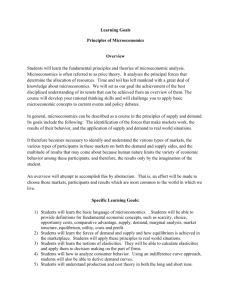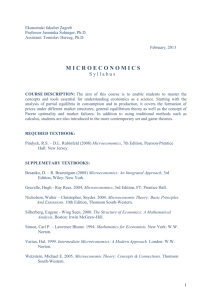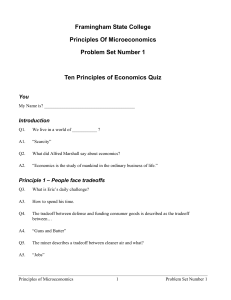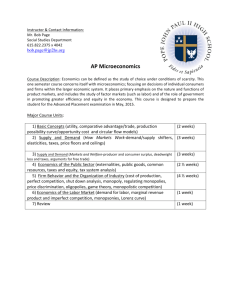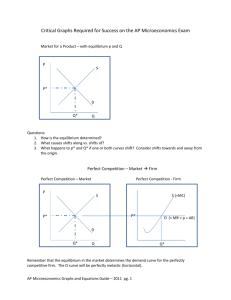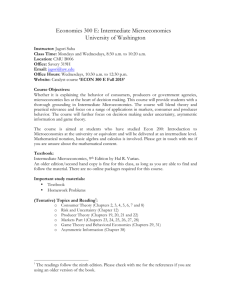ATC
advertisement
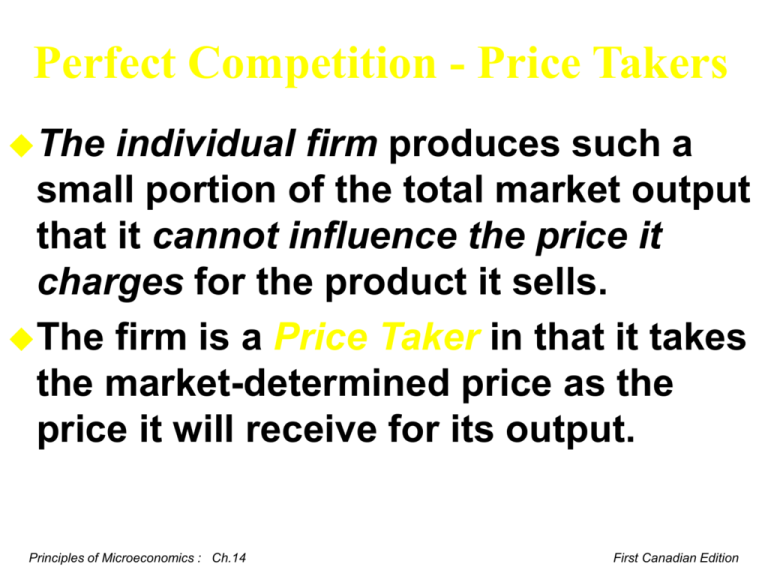
Perfect Competition - Price Takers The individual firm produces such a small portion of the total market output that it cannot influence the price it charges for the product it sells. The firm is a Price Taker in that it takes the market-determined price as the price it will receive for its output. Principles of Microeconomics : Ch.14 First Canadian Edition The Revenue of a Competitive Firm Total Revenue for a firm is the market selling price times the quantity sold. TR = (P x Q) Total revenue is proportional to the amount of output. Graphically: Total revenue increases at a constant rate, as each unit sold sells for a constant price. Principles of Microeconomics : Ch.14 First Canadian Edition Total Revenue: Competitive Firm $ Total Revenue $25 $20 At a market price of $5, total revenue is ($5x1) = $5! $15 $10 $5 1 Principles of Microeconomics : Ch.14 2 3 4 5 Quantity First Canadian Edition Alternative Measurements of Revenue Average – Revenue: Tells us how much revenue a firm receives for the typical unit sold. AR = TR ÷ Q – Average Revenue equals the Price of the good, in Perfect Competition. Principles of Microeconomics : Ch.14 First Canadian Edition Alternative Measurements of Revenue Marginal – Revenue: Tells us how much revenue a firm receives for one additional unit of output. MR = – TR ÷ Q Marginal Revenue equals the Price of the good, in Perfect Competition. Graphically: Each unit sold will add the same amount to total revenue, $5! Principles of Microeconomics : Ch.14 First Canadian Edition Total Revenue: Competitive Firm $ Total Revenue $25 $20 $15 $10 Marginal Revenue $5 1 Principles of Microeconomics : Ch.14 2 3 4 5 Quantity First Canadian Edition Profit Maximization Total Cost $ $25 $20 $15 $10 $5 1 Principles of Microeconomics : Ch.14 2 3 4 5 Quantity First Canadian Edition Profit Maximization Total Cost $ $25 Total Revenue $20 $15 $ Maximum Profit at Q = 3 units! } $10 $5 1 Principles of Microeconomics : Ch.14 2 3 4 5 Quantity First Canadian Edition Profit Maximization Maximum profits occur at a quantity that maximizes the difference (distance) between revenue and costs. Principles of Microeconomics : Ch.14 First Canadian Edition The Competitive Firm’s Cost Curves Revisit of average cost curves: The marginal-cost curve (MC) eventually increases. – The average-total-cost curve (ATC) is Ushaped. – Marginal Cost crosses the Average-TotalCost at the minimum ATC. – Graphically. Principles of Microeconomics : Ch.14 .. First Canadian Edition The Shape of Typical Cost Curves MC AVC Cost ($’s) Principles of Microeconomics : Ch.14 ATC Quantity First Canadian Edition The Competitive Firm’s ProfitMaximizing Output Add a line for the market price which is the same as the firm’s average revenue (AR) and its marginal revenue (MR). Identify the level of output that maximizes profit. Principles of Microeconomics : Ch.14 First Canadian Edition The Competitive Firm’s ProfitMaximizing Output Price MC ATC P=MR=AR AVC Principles of Microeconomics : Ch.14 QMax Quantity First Canadian Edition The Competitive Firm’s ProfitMaximizing Output Price MC P ATC P=MR=AR AVC ATC Maximum Profit Principles of Microeconomics : Ch.14 QMax Quantity First Canadian Edition The Competitive Firm’s Shut-Down Decision Alternative levels of output produced because the firm is a price taker. If the selling price is below the minimum average variable cost, the firm should shut-down! The minimum loss would equal to the firm’s Total Fixed Cost. Principles of Microeconomics : Ch.14 First Canadian Edition Shut-Down! Costs are greater than market price Price MC ATC AVC Q Don’t Produce! P=MR=AR Loss in Excess of Fixed Costs Quantity Principles of Microeconomics : Ch.14 First Canadian Edition Short-Run Production Minimize Losses when MR = MC Price MC ATC AVC ATC P P=MR=AR Losses are less than fixed costs Q short-run Principles of Microeconomics : Ch.14 Quantity First Canadian Edition Short-Run Production Maximize Profits when MR = MC Price MC ATC P P=MR=AR ATC AVC Maximum Economic Profit Principles of Microeconomics : Ch.14 QMax Quantity First Canadian Edition Long-Run Production Normal Profits when MR = MC In the long-run the typical firm will operate where: MR = MC Normal Profit where Price = ATC Minimum ATC Why? Due to Easy Entry Due to Intense Competition Principles of Microeconomics : Ch.14 First Canadian Edition Long-Run Production Price Normal Profits when MR = MC MC ATC P=MR=AR Principles of Microeconomics : Ch.14 QLR Quantity First Canadian Edition The Competitive Firm’s Supply Curve Short-Run Supply: – Is the portion of its marginal cost curve that lies above average variable cost. Long-Run Supply: – Is the marginal cost curve above the minimum point of its average total cost curve. Principles of Microeconomics : Ch.14 First Canadian Edition Competitive Firm’s SR Supply Curve Price MC ATC P=MR=AR AVC P1 Q1 Principles of Microeconomics : Ch.14 Quantity First Canadian Edition The Competitive Firm’s Supply Curve Price MC P3 ATC P=MR=AR AVC P2 P1 Q1 Principles of Microeconomics : Ch.14 Q2 Q3 Quantity First Canadian Edition The Competitive Firm’s Supply Curve Price P3 P2 Firms ShortRun Supply Curve P1 Q1 Principles of Microeconomics : Ch.14 Q2 Q3 Quantity First Canadian Edition The Firm’s Profit Profit equals total revenue (TR) minus total costs (TC) Profit = TR - TC – Profit = ([TR ÷ Q] - [TC ÷ Q]) x Q – Profit = (P - ATC) x Q – Principles of Microeconomics : Ch.14 First Canadian Edition The Competitive Firm’s Decision To Produce, Shut-Down or Exit In the short-run, a firm will choose to shut-down temporarily if the price of the good is less than the average variable cost. In the long-run when the firm can recover both fixed and variable costs, the firm will choose to exit if the price is less than average total cost. Principles of Microeconomics : Ch.14 First Canadian Edition The Market Supply Curve For any given price, each firm supplies a quantity of output so that price equals its marginal cost. The quantity of output supplied to the market equals the sum of the quantities supplied by the individual firms. Principles of Microeconomics : Ch.14 First Canadian Edition The Market Supply Curve Firms will enter or exit the market until profit is driven to zero. In the long-run, price equals the minimum of average total cost. Because firms can enter and exit more easily in the long-run than in the shortrun, the long-run supply curve is more elastic than the short-run supply curve. Principles of Microeconomics : Ch.14 First Canadian Edition Summary/Conclusion If business firms are competitive and profit-maximizing, the price of a good equals the marginal cost of making that good. If firms can freely enter and exit the market, the price also equals the lowest possible average total cost of production. Principles of Microeconomics : Ch.14 First Canadian Edition

